INTRODUCTION
Numerous biological processes manifest intrinsically within the human organism, encompassing respiration, food digestion, alcohol metabolism, drug metabolism, and the enzymatic conversion of lipids into perilous energy entities commonly referred to as free radicals [1]. When the organism’s capacity to regulate free radicals is depleted, oxidative stress ensues. Despite diverse antioxidant enzymes and highly efficient natural antioxidant defenses in the skin, the efficacy of these mechanisms may be limited due to an excessive generation of reactive oxygen species. This imbalance between antioxidant and oxidant activity results in cellular oxidative stress, as documented by Stojiljkovic et al. [2]. Hence, the utilization of exogenous antioxidants has the potential to effectively regulate and mitigate the detrimental effects of oxidative stress, as suggested by Lobo et al. [3].
Exogenous antioxidants are derived from extrinsic sources and can be classified as naturally occurring or synthetically produced. Natural antioxidants are derived from natural sources, whereas synthetic antioxidants result from chemical processes [4]. The drug delivery process involves administering a pharmaceutical substance, such as exogenous antioxidants, into the physiological system of a human organism to acquire and enhance. The primary objective of drug delivery is to optimize therapeutic efficacy through the controlled transportation and subsequent release of pharmaceutical agents to specific anatomical sites within the human body, either through passive or active mechanisms. Simultaneously, minimizing the undesired accumulation of drugs in nontargeted regions is crucial, as Vargason et al. [5] highlighted in their recent publication. Examples of drug delivery systems include oral administration, transdermal administration, lung inhalation, mucosal administration, and intravenous injection. Exogenous antioxidants are commonly administered through oral and parenteral methods. Transdermal drug delivery can bypass the numerous inherent constraints associated with conventional pharmaceutical delivery pathways [6].
The transdermal drug delivery system, characterized by administering a pharmaceutical formulation through the skin, represents a noninvasive approach to achieving systemic drug delivery without pain [7]. Permeation through the transdermal route can be augmented by various mechanisms, primarily involving the alteration or modification of the physical–chemical characteristics of the stratum corneum. In addition, the penetration of drugs into the stratum corneum can be enhanced by engaging with intercellular components within the stratum corneum. Utilizing a vesicle carrier represents one of the diverse methodologies for augmenting medication permeation within the stratum corneum. Lipid-based vesicle carriers encompass diverse types, including liposomes, transfersomes, ethosomes, niosomes, and phytosomes, as elucidated by Opatha et al. [8].
Liposomes possess considerable potential as efficacious drug delivery systems due to their dimensions, hydrophobic and hydrophilic characteristics, and capacity to encapsulate drug molecules within the aqueous interior or lipophilic membrane [9]. Liposomes possess a notable appeal as a drug delivery system due to their capacity to replicate the shape and chemical composition of cell membranes. Liposomes can be readily generated by utilizing nontoxic, nonimmunogenic, naturally occurring, and biodegradable amphiphilic compounds. Liposomal formulations exhibit superior suitability for sensitive skin compared to ethosomes due to the absence of ethanol within liposomes, thereby mitigating the potential for skin irritation. Liposomes have been observed to enhance the stability of substances in the surrounding environment and the presence of oxidation, as reported by Sen et al. [10]. While the potential of transdermal liposomes for antioxidant therapy is promising, the number of medications within this category that have undergone clinical trials remains limited. Hence, a comprehensive series of inquiries and examinations are required to develop the optimal transdermal liposomes, which can be accomplished through bibliometric analysis.
Bibliometric analysis is a methodological approach employed to elucidate and cartographically represent the corpus of scientific knowledge by harnessing unstructured data from many scholarly investigations [11]. Furthermore, the proposed methodology can assess the caliber of the study, scrutinize the principal domains of investigation, and prognosticate the trajectory of forthcoming inquiries [12]. A comprehensive bibliometric analysis examining the utilization of transdermal liposomes as antioxidants from 2013 to 2023 is currently lacking. The present bibliometric analysis employs a retrospective research approach to investigate the conceptual framework of the subject matter. This investigation examines publication trends, institutions involved, sources of information, individual papers, and the networks and overlays formed by the co-occurrence of keywords. Consequently, this study aims to elucidate a comprehensive comprehension of the antioxidant properties exhibited by transdermal liposomes.
MATERIALS AND METHODS
Study technique and search strategy
The data utilized in this study were obtained from the PubMed database [https://pubmed.ncbi.nlm.nih.gov/] on April 13, 2023. The investigation specifically concentrated on the timeframe spanning from 2013 to 2023, with a particular emphasis on articles written in English and classified as the document type. The PubMed searches used “transdermal liposome” and “antioxidant” as keywords. The data underwent a rigorous cleaning and verification process to eradicate any instances of duplicate data and to ensure the accuracy of the retrieved articles about transdermal liposomes as antioxidants. Systematic searches were conducted to ascertain the appropriateness of the selected article. The data that had been gathered was subsequently exported in the form of an Excel comma-separated values file.
Data analysis
The VOSviewer program version 1.6.19 was made available by the Center for Science and Technology Studies at Leiden University in The Netherlands. The program examined the analysis of keyword co-occurrences. The process of data cleansing was conducted utilizing thesaurus software to mitigate the occurrence of data duplication. The data analysis was performed using the RStudio program version 2023.03.0–386 with the assistance of Bibliometrix, a software tool developed by the Department of Economics and Statistics at the University of Naples Federico II in Italy. The present study analyzed publication patterns, encompassing various aspects such as contributing institutions, sources, authors, and papers.
RESULT AND DISCUSSION
Data searches
Table 1 presents the results of a data search. Upon searching using the keywords “transdermal liposome” and “antioxidant” in the PubMed search engine, 63 articles were retrieved. We have excluded a maximum of 10 articles from our analysis due to their lack of publication within the temporal range of the past decade (2013–2023). We possessed a high level of confidence in the contemporaneity and precision of our data, as certain circumstances can undergo significant alterations within a brief temporal interval. Our research employs contemporary and relevant scholarly publications, focusing on articles published in the last decade. In addition, we have identified two articles that do not explore transdermal liposome administration to deliver antioxidants. By restricting the scope of the analysis to pertinent articles, we can enhance the contextualization of the analysis.
Furthermore, including extraneous articles will introduce data noise, potentially complicating the interpretation process. By directing attention toward pertinent articles during the analysis process, the resultant conclusions and findings attained a higher degree of validity and were readily embraced by the scientific community. Henceforth, a total of 51 articles were employed to conduct bibliometric analysis.
The flowchart in Figure 1 illustrates the sequential steps in conducting an article search. A bibliometric analysis used transdermal liposomes for antioxidants. The analysis involved querying the PubMed database to identify and categorize knowledge concepts associated with advancing research in antioxidant and drug delivery systems employing transdermal liposome technology. The bibliometric analysis comprises two distinct components, namely performance analysis and science mapping, as elucidated by Dede and Ozdemir [13]. The performance analysis evaluates the contributions of researchers from various nations, institutions, sources, and authors, which collectively enhance the articles’ productivity [14]. In scientific inquiry, mapping visually represents the intricate framework of knowledge and its evolution within the research domain. In addition, the study elucidates the intricate dynamics and interconnections among the various components of the research as well as the robustness of their associations [13].
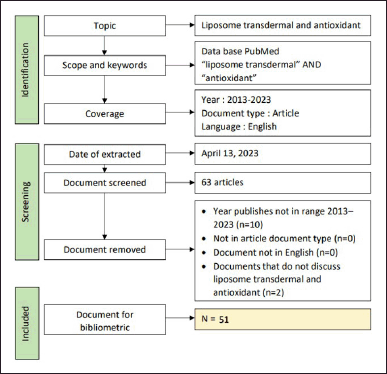 | Figure 1. Articles search procedures. [Click here to view] |
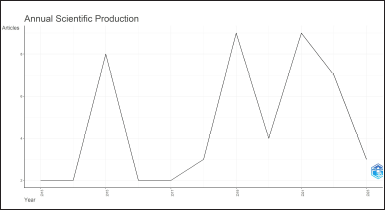 | Figure 2. The annual production of scientific papers from 2013 to 2023. [Click here to view] |
Publication trend
As depicted in Figure 2, a consistent and uninterrupted rate of article generation has been observed since 2015. Table 2 presents the mean quantity of citations per article and elucidates the patterns observed in the publication date data. Based on statistical analysis, the average number of citations generated per article annually is 29.85, with a cumulative output of 4.64 articles per year. 2019 and 2021 have exhibited the utmost magnitude of article production, with nine articles each year. After the year 2015, a total of eight articles were generated, and in the year 2022, a total of seven articles were produced. The year 2017 (83.5), followed by 2013 (74.5) and 2015 (38.62), exhibits the most elevated mean citation count per article. Elevated citation metrics associated with a scholarly article serve as a reliable indicator of the profound impact exerted by the scientific knowledge encapsulated within the article, thereby establishing a solid groundwork for subsequent investigations [15].
Analysis of the contributing institution
A link clarification procedure was implemented to ascertain the most pertinent links. The primary entities engaged in research about this subject matter are enumerated utilizing the document co-authoring index presented by Abafe et al. [16]. According to the data presented in Figure 3, the Anhui Institute for Food and Drug Control, the Anhui University of Chinese Medicine, and the Clinical College of Anhui Medical University are the primary institutions associated with the production of scholarly articles about the application of transdermal liposome as antioxidants. Following the collaborative network, Table 3 presents the institution that has exhibited the highest level of productivity in generating scholarly articles about the utilization of transdermal liposome antioxidants. Remarkably, Anhui University of Chinese Medicine has emerged as the most productive institution, having successfully produced 20 articles on this subject matter. After being affiliated with Fujian Medical University and the University of Cagliari, the individual in question has successfully contributed to the scientific community by publishing 16 articles at each institution. The University of Coimbra, with 14 articles, ranks as the fourth most productive institution. The Seoul National University of Science and Technology has generated 13 scholarly articles.
Analysis of contributing source
Based on the data provided by RStudio, 51 scholarly articles were collected from 32 distinct sources or journals, all of which delve into the topic of transdermal liposomes as antioxidants. The correlation between the number of articles generated from a particular source and their relevance to transdermal liposome as antioxidant research is positively proportional. According to the findings presented in Table 4, the most prominent sources for transdermal liposome as antioxidant research within 2013–2023 are outlined. The primary source of utmost relevance is the “International Journal of Pharmaceutics” with seven scholarly articles. Subsequently, the “AAPS Pharmcitech” journal exhibits three articles of notable significance.
In addition, the “Journal of Liposome Research” and the “Journal of Microencapsulation” contribute three articles to the scientific discourse in this field. The “International Journal of Pharmaceutics” stands out as the most frequently referenced publication regarding scholarly articles exploring the utilization of transdermal liposomes as antioxidants. This particular source has garnered a notable total of 233 citations, resulting in an average of 38.83 citations per individual document. The periodical “Colloids and Surfaces B: Bionterfaces” exhibits the second-highest citation count, amounting to 213 citations. This results in an average of 106.5 citations per document. Figure 4 depicts the ten most prominent sources as per the H-index. The sources that exhibit the highest degree of impact are the “International Journal of Pharmaceutics” with a notable index score of 6, followed by the “AAPS Pharmcitech” and the “Journal of Liposome Research”, both of which possess index scores of 3.
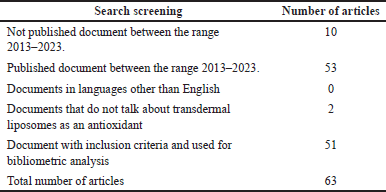 | Table 1. Results of a data search using the PubMed search engine. [Click here to view] |
The observed index points suggest that other scholars have referenced the source in question a minimum extent of the value above [11]. Figure 5 illustrates the observed correlation among author affiliation (AU_UN), sources/journals (SO), and the country of the author (AU_CO). Gray lines interconnect the three regions. The longitudinal dimension of the rectangular shape serves as a quantitative representation of the number of associated entities within each compartment. The relationship between the length of the rectangle and the number of items contained within each box becomes increasingly apparent as the length of the rectangle increases. The data presented in Table 4, Figures 4 and 5 support the notion that the International Journal of Pharmaceutics exhibits the highest level of influence in the transdermal liposome as an antioxidant research field. The scholarly institutions, namely the University of Cagliari, the University of Coimbra, the Seoul National Institute of Science and Technology, and the University of Calabria have chosen the International Journal of Pharmaceutics platform for disseminating their research findings. Based on an outflow analysis, it has been determined that this publication has disseminated articles authored by 5 out of 14 writers. The articles authored by the Seoul National University of Science and Technology and the University of Calabria are disseminated through publication in the esteemed International Journal of Pharmaceutics. The outflow data analysis reveals that this journal has disseminated scholarly articles from diverse nations. The group includes Italy, Korea, Portugal, India, and Spain.
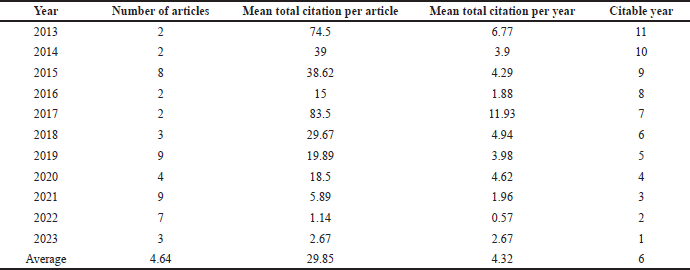 | Table 2. Publication of data trends by year using the RStudio application. [Click here to view] |
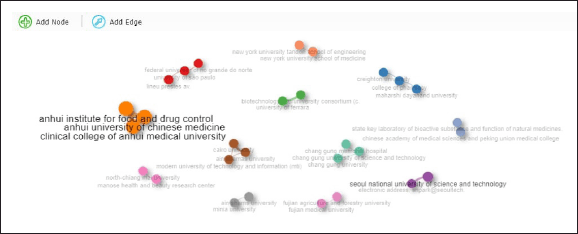 | Figure 3. Affiliation collaboration network using the RStudio application. [Click here to view] |
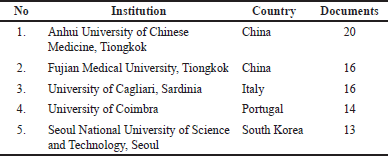 | Table 3. The organization with the highest productivity using the RStudio application. [Click here to view] |
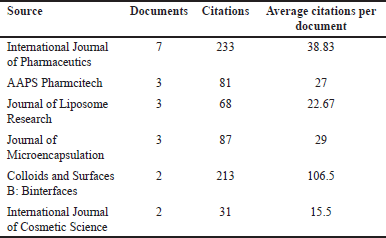 | Table 4. The most productive source is the RStudio application. [Click here to view] |
Analysis of contributing author
The number assigned to the H index depicted in Figure 6 is a quantitative measure of the author’s impact and influence within the scholarly community. According to the H-index measurement of the scientific literature about transdermal liposomes as antioxidants, Caddeo C received the highest H-index score of 4 and made the most significant contributions. Following closely behind with an equivalent H-index score is Fadda AM. Manconi M and Park SN also attained an H-index score of 3, signifying their notable impact in this field. Caddeo C’s articles primarily focus on encapsulating antioxidant compounds within liposomes or phospholipid vesicles. The provided data holds significant value for individuals engaged in the composition of scientific articles, particularly researchers, as it aids in the formulation and discourse of research study outcomes and their consequential influence. Following Table 5, the preeminent quintet of authors is presented, showcasing their prolific contributions to transdermal liposomes and antioxidants. The present study was conducted to obtain comprehensive insights into transdermal liposome properties and their antioxidant activity.
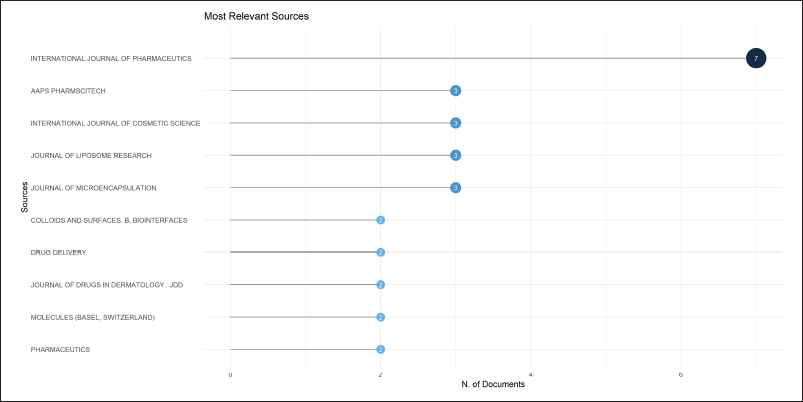 | Figure 4. Highest impact source for transdermal liposome as an antioxidant using RStudio application. [Click here to view] |
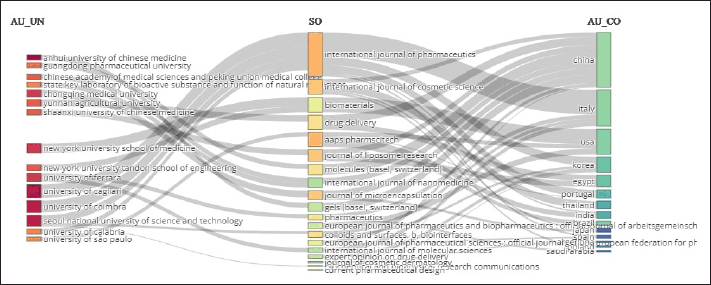 | Figure 5. Three-field plot between author affiliations (AU_UN), Source (SO), and author country (AU_CO) using the RStudio application. [Click here to view] |
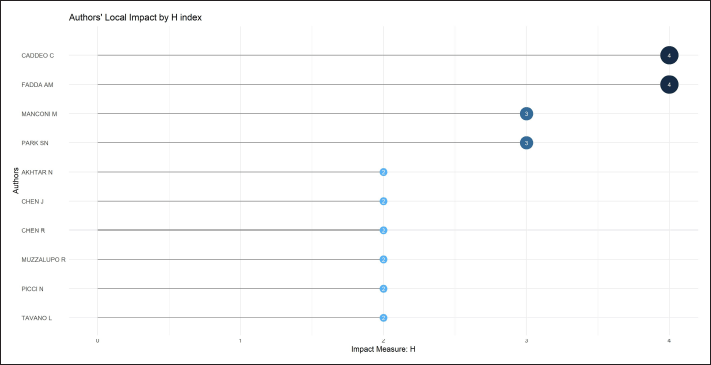 | Figure 6. Author local impact based on the H index using with RStudio application. [Click here to view] |
Caddeo C, hailing from the esteemed University of Cagliari, has successfully disseminated its research findings by publishing four scholarly papers spanning 2013–2021. Remarkably, these papers have garnered an average of 31 citations per publication, indicating their significant impact on the scientific community. The second individual identified in this study is Fadda AM, affiliated with the esteemed University of Pisa. Fadda AM has contributed to the scientific community by authoring four scholarly papers from 2013–2021. Notably, these papers have garnered an average of 31 citations per publication, indicating their impact and recognition within the scientific discourse. The collaborative efforts of Fadda AM and Caddeo C have been evidenced in their joint authorship of various scholarly articles. From 2022 to 2023, Cheng Y from the Anhui Medical University and the University of Science and Technology of China wrote three articles with an average citation rate of 0.33 per publication. The individual identified as Manconi M, hailing from the esteemed University of Cagliari, has been credited as the sole author of three scholarly articles from 2013 to 2016. These articles have garnered an average of 39.67 citations per publication, indicating their impact and recognition within the scientific community. The scholarly output of Park SN, an esteemed researcher affiliated with the Seoul National University of Science and Technology, encompasses three publications spanning 2013–2015. Notably, these papers have garnered an impressive average of 92.67 citations per publication, indicating their significant impact on the scientific community.
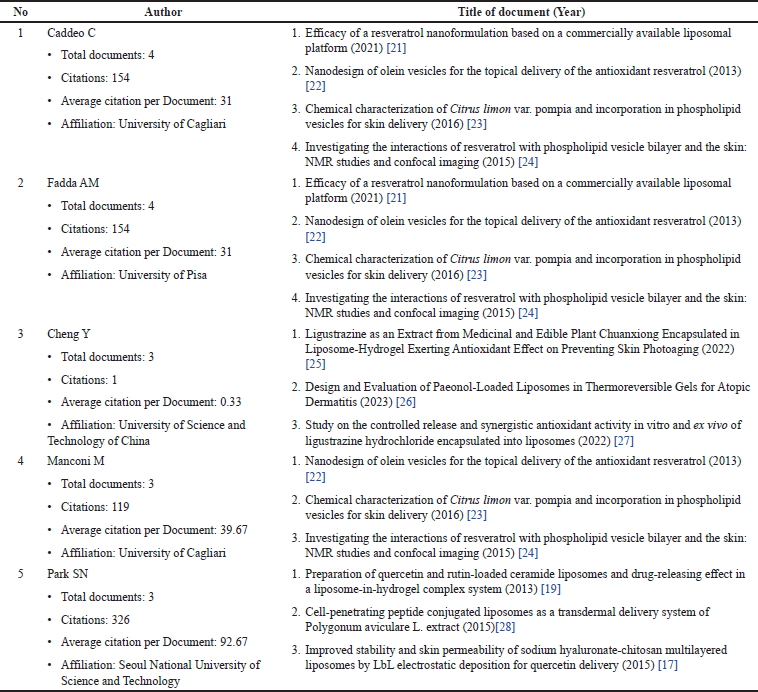 | Table 5. Top five authors with the highest output using the RStudio application. [Click here to view] |
Analysis of contributing paper
The quantification of citations garnered by a scholarly article indicates the study that has made the most substantial and noteworthy contribution. The correlation between the number of citations a publication receives and its impact on advancing transdermal liposome as antioxidants research is positively associated. As per the findings from RStudio, it has been observed that the compilation of the top 10 most referenced articles was accomplished through the collective efforts of 51 papers, as visually depicted in Table 6. The article by Jeon et al. [17] titled “Improved Stability and Skin Permeability of Sodium Hyaluronate-Chitosan Multilayered Liposomes by Layer-by-Layer (LbL) Electrostatic Deposition for Quercetin Delivery” got the most citations from scientists. The present investigation has successfully showcased the efficacy of LbL technology, which relies on the electrostatic forces between polyelectrolytes. This technique, specifically advantageous for transdermal administration, has enhanced the durability of drug delivery systems. Based on the study’s results, it has been seen that using sodium hyaluronate and chitosan polyelectrolytes to coat multilayer liposomes in the right way makes them more stable because electrostatic interactions are made. Consequently, this approach holds promise as a potential strategy for facilitating the transdermal distribution of the hydrophobic antioxidant quercetin [17].
The article titled “Novel Lipoproteoplex (LPP) Delivers Keap1 siRNA-based Gene Therapy to Accelerate Diabetic Wound Healing” by Rabbani et al. [18] garnered 88 citations, making it the second most influential article in its field. This study aimed to enhance a newly developed liposome–protein hybrid nanoparticle delivery technology for the localized treatment of diabetic ulcers characterized by significant oxidative stress. In the present investigation, a cationic lipid nanoparticle incorporating 1,2-dioleoyl-3-trimethylammonium propane (DOTAP) and sodium cholate (NaChol) was employed as an edge activator in a 6:1 ratio of DOTAP to NaChol (referred to as DNC). Through the utilization of a cationically engineered supercharged coiled-coil protein (CSP) in a ratio of 10:1:1 with DNC, CSP, and siRNA, an LPP nanoparticle of notable stability was successfully synthesized. According to Rabbani et al. [18], the LPP nanoparticle demonstrates superior siRNA complexation capabilities, exhibiting the highest transfection efficiency while minimizing cytotoxicity.
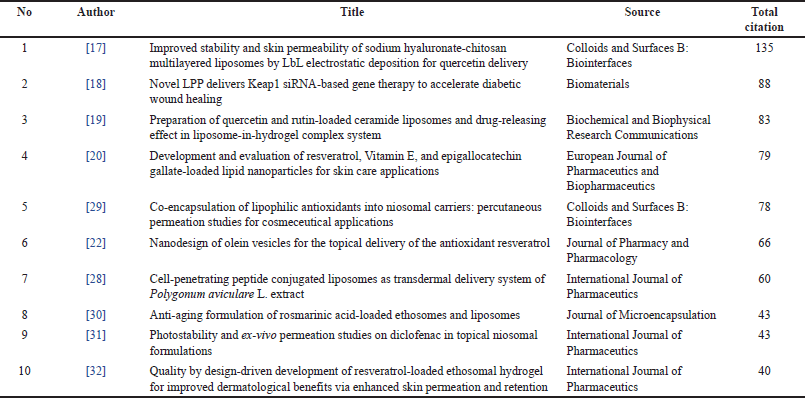 | Table 6. Most cited articles using the RStudio application. [Click here to view] |
In the realm of scholarly discourse, it is worth noting that the scholarly work conducted by Park et al. [19], titled “Preparation of Quercetin and Rutin-Loaded Ceramide Liposomes and Drug-Releasing Effect in a Liposome-in-Hydrogel Complex System” has garnered considerable attention. This article has been cited 83 times, thus solidifying its position as the third most frequently cited publication. The current study sought to develop a two-step delivery method to improve the transdermal permeation of the antioxidant quercetin and its glycoside rutin. Liposome-in-hydrogel complex systems were made when ceramide liposomes, which have lipid membranes that work with biological systems, were mixed with cellulose hydrogel. The stability of various formulations was assessed for 3 weeks, focusing on parameters such as encapsulation efficiency, in vitro release, and skin permeability. Park et al. [19] found that the results suggest that liposome-in-hydrogel systems can be used as drug delivery systems to help the hydrophobic antioxidants quercetin and rutin be taken in through the skin.
The research conducted by Chen et al. [20], titled “Development and Evaluation of Resveratrol, Vitamin E, and Epigallocatechin Gallate-Loaded Lipid Nanoparticles for Skin Care Applications,” garnered a notable 79 citations, positioning it as the fourth most impactful study in the field. The amalgamation of emulsions, liposomes, and polymeric particles in solid lipid nanoparticles (SLN) and nanostructured lipid carriers (NLC) consolidates their benefits. Consequently, these entities exhibit notable encapsulation, heightened active safeguarding, and mastery over the intended release profile. In this investigation, robust antioxidants, namely resveratrol, tocopherol, and catechin, renowned for their skin-protective properties, were employed to produce lipid nanoparticles. A multitude of meticulously devised compositions exhibited exemplary uniformity and durability. During research on how things get through the skin, it was found that lipid nanoparticles made it easier for resveratrol to get through the stratum corneum. Based on the results of this study, lipid nanoparticles could be an excellent way to deliver resveratrol and vitamin E to the dermal layer [20].
Analysis of keyword co-occurrence
The minimum word count for utilization of VOSviewer has been established at 10. After completing the VOSviewer analysis, 16 distinct clusters were observed to have formed. Each cluster effectively demonstrates the interrelationship between individual topics. The software allows for the visualization of bibliometric mapping through three distinct modalities. The visual representation of the network can be observed in Figure 7. The keywords were visually depicted as circles of varying colors, with their respective sizes directly corresponding to their frequencies within the titles and abstracts.
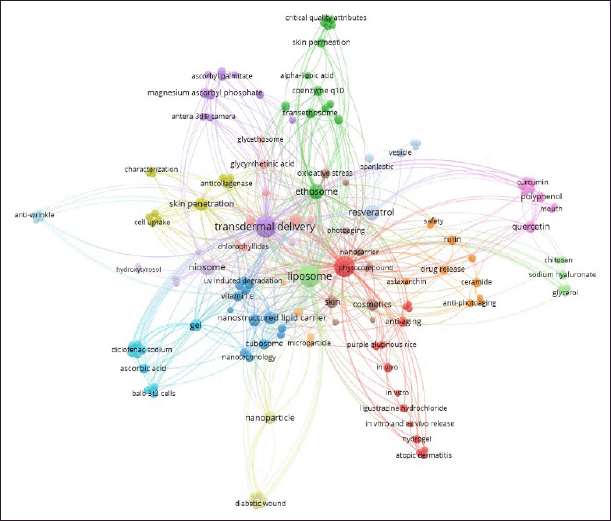 | Figure 7. Visualization topic area by VOSviewer using network visualization. [Click here to view] |
Consequently, the dimensions of the letters and circles were determined based on their respective frequencies of occurrence. The observed phenomenon reveals a higher frequency of occurrence for a given keyword when the dimensions of the letters and circles are increased. A corpus of 51 connected articles was used to find 147 keywords. The focus was on the empirical data from articles about how transdermal liposome delivery systems can be used as antioxidants. Figure 7 illustrates the clusters observed within each of the issue areas examined. The consistent coloration of each keyword signifies a strong correlation among them. The entities denoted by the terms “liposome,” “sodium hyaluronate,” “chitosan,” “LbL ,” and “glycerol” exhibit a common chromatic attribute, signifying their interconnectedness and cohesive categorization. Based on the data presented in Figure 7, it can be observed that the keywords “liposome,” “transdermal delivery,” “antioxidant,” “ethosome,” “resveratrol,” and “niosome” exhibit varying frequencies and total link strengths. Specifically, “liposome” appears 29 times with a total link strength of 142, “transdermal delivery” occurs 28 times with a total link strength of 142, “antioxidant” is present 29 times with a total link strength of 133, “those” is found eight times with a total link strength of 50, “resveratrol” is mentioned nine times with a total link strength of 46, and “niosome” is referenced nine times with a total link strength of 45. Based on the obtained results, it is evident that transdermal liposome application exhibits novel characteristics in the realm of antioxidant research.
CONCLUSION
Based on bibliometric analysis, 51 scholarly articles have been identified that explore the utilization of transdermal liposomes as an antioxidant. The mean number of publications published annually was calculated to be 4.67, while the mean number of citations received per publication amounted to 29.85. According to the findings of the performance analysis, it has been determined that the Anhui University of Chinese Medicine exhibited the highest level of productivity among the institutions under investigation, having generated a total of 20 articles. The journal that exerted the most significant impact was the “International Journal of Pharmaceutics,” which boasted seven articles and garnered a noteworthy 233 citations. Scientific mapping revealed that Caddeo C’s research on transdermal liposomes as antioxidants significantly impacted publications due to their impressive H index of 4 and an average of 31 citations per article. The keyword “liposome” exhibits the highest frequency of occurrence, followed by “transdermal delivery” and “antioxidant”. The article by Jeon et al. [17] has been widely regarded as highly influential, garnering a substantial number of citations, specifically 135. The findings of the investigation indicate that the utilization of appropriately coated multilayer liposomes comprising anionic sodium hyaluronate and cationic chitosan polyelectrolytes holds promise as a prospective mechanism for delivering the hydrophobic antioxidant quercetin through the skin. Researchers can benefit from using bibliometric science mapping analysis because it helps with the strategic planning, careful thought, and careful development of possible future research projects that meet all pharmaceutical requirements for making liposome preparations for the transdermal distribution of antioxidants. This bibliometric science mapping analysis serves as a valuable tool in this process.
Nevertheless, several constraints were present within the scope of this investigation. Specifically, only English-language publications spanning the temporal interval from 2013 to 2023 were encompassed in our comprehensive examination. Furthermore, the selection of keywords was predicated on our acquaintance with the scholarly body of work, potentially influencing the overall quantity and diversity of the articles under scrutiny.
ACKNOWLEDGMENTS
The authors would like to thank the Pharmacy Study Program, Faculty of Mathematics and Natural Sciences, Udayana University, for facilitating this research.
AUTHOR CONTRIBUTIONS
All authors made substantial contributions to the conception and design, acquisition of data, or analysis and interpretation of data; took part in drafting the article or revising it critically for important intellectual content; agreed to submit to the current journal; gave final approval of the version to be published; and agree to be accountable for all aspects of the work. All the authors are eligible to be an author as per the International Committee of Medical Journal Editors (ICMJE) requirements/guidelines.
FINANCIAL SUPPORT
LPPM Udayana University supported this research under contract B/78.676/UN14.4.A/PT.01.03/2022.
CONFLICTS OF INTEREST
The authors report no financial or any other conflicts of interest in this work.
ETHICAL APPROVALS
This study does not involve experiments on animals or human subjects.
DATA AVAILABILITY
All data generated and analyzed are included in this research article.
PUBLISHER’S NOTE
This journal remains neutral with regard to jurisdictional claims in published institutional affiliation.
REFERENCES
1. Sharifi-Rad M, Anil Kumar NV, Zucca P, Varoni EM, Dini L, Panzarini E, et al. Lifestyle, oxidative stress, and antioxidants: back and forth in the pathophysiology of chronic diseases. Front Physiol. 2020;11:1–21.
2. Stojiljkovic D, Pavlovic D, Arsic I. Oxidative stress, skin aging and antioxidant therapy. Acta Fac Med Naissensis. 2014;31:207–17.
3. Lobo V, Patil A, Phatak A, Chandra N. Free radicals, antioxidants and functional foods: impact on human health. Pharmacogn Rev. 2010;4:118–26.
4. Mahmoud AM, Wilkinson FL, Lightfoot AP, Dos Santos JM, Sandhu MA. The role of natural and synthetic antioxidants in modulating oxidative stress in drug-induced injury and metabolic disorders 2020. Oxid Med Cell Longev. 2021;2021:1–3.
5. Vargason AM, Anselmo AC, Mitragotri S. The evolution of commercial drug delivery technologies. Nat Biomed Eng. 2021;5(9):951–67.
6. Alkilani AZ, McCrudden MTC, Donnelly RF. Transdermal drug delivery: innovative pharmaceutical developments based on disruption of the barrier properties of the stratum corneum. Pharmaceutics. 2015;7:438–70.
7. Han T, Das DB. Potential of combined ultrasound and microneedles for enhanced transdermal drug permeation: a review. Eur J Pharm Biopharm. 2015;89:312–28.
8. Opatha SAT, Titapiwatanakun V, Chutoprapat R. Transfersomes: a promising nanoencapsulation technique for transdermal drug delivery. Pharmaceutics. 2020;12:1–23.
9. Nsairat H, Khater D, Sayed U, Odeh F, Al Bawab A, Alshaer W. Liposomes: structure, composition, types, and clinical applications. Heliyon. 2022;8:1–15.
10. Sen R, Sahoo SK, Satpathy S. Liposomes as drug delivery system: a brief review. Int J Res Pharm Sci [Internet]. 2014;5:309–21. Available from: www.ijrps.pharmascope.org
11. Fatimah SF, Lukitaningsih E, Martien R, Nugroho AK. Bibliometric analysis of articles on nanoemulsion and/or in-situ gel for ocular drug delivery system published during the 2011–2021 period. Pharmacia. 2022;69:467–84.
12. Yu Y, Li Y, Zhang Z, Gu Z, Zhong H, Zha Q, et al. A bibliometric analysis using VOSviewer of publications on COVID-19. Ann Transl Med. 2020;8:816.
13. Dede E, Ozdemir E. Mapping and performance evaluation of mathematics education research in Turkey: a bibliometric analysis from 2005 to 2021. J Pedagogical Res. 2022;6:1–19.
14. Donthu N, Kumar S, Mukherjee D, Pandey N, Lim WM. How to conduct a bibliometric analysis: an overview and guidelines. J Bus Res. 2021;133:285–96.
15. Kraus S, Filser M, O’Dwyer M, Shaw E. Social entrepreneurship: an exploratory citation analysis. Rev Manag Sci. 2013;8:275–92.
16. Abafe EA, Bahta YT, Jordaan H. Exploring biblioshiny for historical assessment of global research on sustainable use of water in agriculture. Sustainability. 2022;14:1–34.
17. Jeon S, Yoo CY, Park SN. Improved stability and skin permeability of sodium hyaluronate-chitosan multilayered liposomes by layer-by-layer electrostatic deposition for quercetin delivery. Colloids Surf B Biointerfaces. 2015;129:7–14.
18. Rabbani PS, Zhou A, Borab ZM, Frezzo JA, Srivastava N, More HT. Novel lipoproteoplex delivers Keap1 siRNA based gene therapy to accelerate diabetic wound healing. Biomaterials. 2017;132:1–15.
19. Park SN, Lee MH, Kim SJ, Yu ER. Preparation of quercetin and rutin-loaded ceramide liposomes and drug-releasing effect in liposome-in-hydrogel complex system. Biochem Biophys Res Commun. 2013;435:361–6.
20. Chen J, Wei N, Lopez-Garcia M, Ambrose D, Lee J, Annelin C, et al. Development and evaluation of resveratrol, Vitamin E, and epigallocatechin gallate loaded lipid nanoparticles for skin care applications. Eur J Pharm Biopharm. 2017;117:286–91.
21. Caddeo C, Lucchesi D, Fernàndez-Busquets X, Valenti D, Penno G, Fadda AM, et al. Efficacy of a resveratrol nanoformulation based on a commercially available liposomal platform. Int J Pharm. 2021;608:121086.
22. Pando D, Caddeo C, Manconi M, Fadda AM, Pazos C. Nanodesign of olein vesicles for the topical delivery of the antioxidant resveratrol. J Pharm Pharmacol. 2013;65:1158–67.
23. Manconi M, Manca ML, Marongiu F, Caddeo C, Castangia I, Petretto GL, et al. Chemical characterization of Citrus limon var. pompia and incorporation in phospholipid vesicles for skin delivery. Int J Pharm. 2016;506:449–57.
24. Caddeo C, Manconi M, Cardia MC, Díez-Sales O, Fadda AM, Sinico C. Investigating the interactions of resveratrol with phospholipid vesicle bilayer and the skin: NMR studies and confocal imaging. Int J Pharm. 2015;484:138–45.
25. Liu C, Xia Y, Li Y, Cheng Y, Xia H, Wang Y, et al. Ligustrazine as an extract from medicinal and edible plant chuanxiong encapsulated in liposome–hydrogel exerting antioxidant effect on preventing skin photoaging. Polymers (Basel). 2022;14(21):4778.
26. Wang Y, Yue Y, Jia R, Liu X, Cheng Z, Cheng Y, et al. Design and evaluation of paeonol-loaded liposomes in thermoreversible gels for atopic dermatitis. Gels. 2023;9(3):198.
27. Li Y, Cheng Y, Xia H, Zhang Q, Yue Y, Xia Y, et al. Study on the controlled release and synergistic anti-oxidant activity in vitro and ex vivo of ligustrazine hydrochloride encapsulated into liposomes. Pak J Pharm Sci. 2022;35:1503–12.
28. Kwon SS, Kim SY, Kong BJ, Kim KJ, Noh GY, Im NR, et al. Cell penetrating peptide conjugated liposomes as transdermal delivery system of Polygonum aviculare L. extract. Int J Pharm. 2015;483:26–37.
29. Tavano L, Muzzalupo R, Picci N, de Cindio B. Co-encapsulation of lipophilic antioxidants into niosomal carriers: percutaneous permeation studies for cosmeceutical applications. Colloids Surf B Biointerfaces. 2014;114:144–9.
30. Yücel Ç, Seker Karatoprak G, Degim IT. Anti-aging formulation of rosmarinic acid-loaded ethosomes and liposomes. J Microencapsul. 2019;36:180–91.
31. Ioele G, Tavano L, De Luca M, Ragno G, Picci N, Muzzalupo R. Photostability and ex-vivo permeation studies on diclofenac in topical niosomal formulations. Int J Pharm. 2015;494:490–7.
32. Arora D, Nanda S. Quality by design driven development of resveratrol loaded ethosomal hydrogel for improved dermatological benefits via enhanced skin permeation and retention. Int J Pharm. 2019;567:118448.